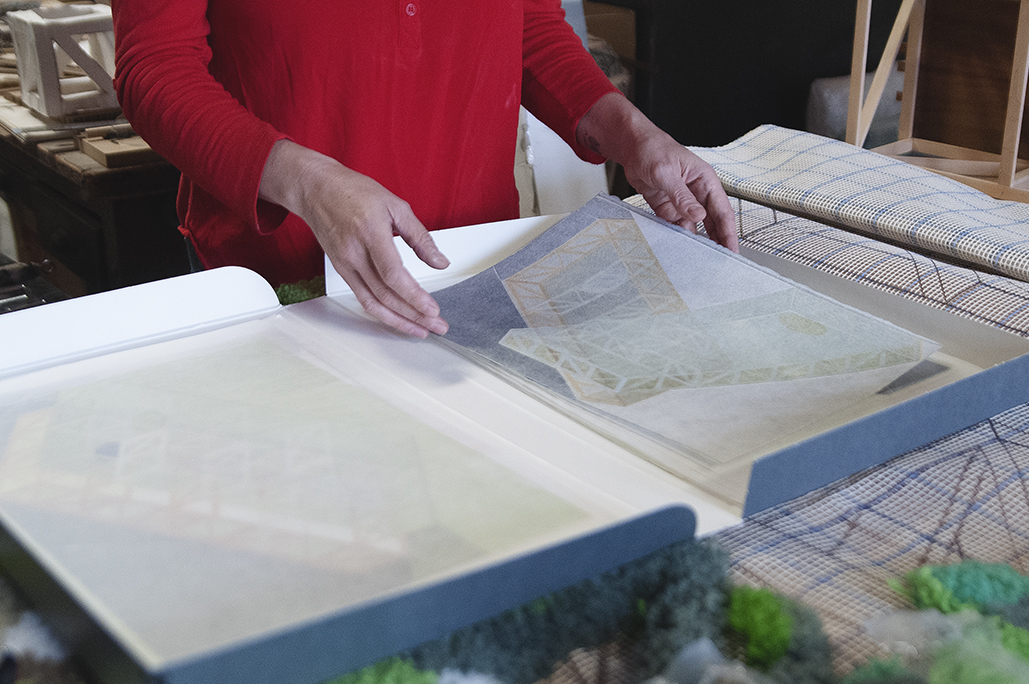Inside\Within is a constantly updating web archive devoted to physically exploring the creative spaces of Chicago's emerging and established artists.
Support for this project was provided by The Propeller Fund, a joint administrated grant from Threewalls and Gallery 400 at The University of Illinois at Chicago.

Search using the field below:
Or display posts from these tags:
3D printing 3D scanning 65 Grand 7/3 Split 8550 Ohio 96 ACRES A+D Gallery ACRE animation Art Institute of Chicago Arts Incubator Arts of Life audio blogging Brain Frame CAKE Carrie Secrist Gallery casting ceramics Chicago Artist Writers Chicago Artists Coalition Chicago Cultural Center Cleve Carney Art Gallery Clutch Gallery Cobalt Studio Coco River Fudge Street collage collection Columbia College Chicago Comfort Station comics conceptual art Contemporary Art Daily Corbett vs. Dempsey Creative Capital DCASE DePaul University design Devening Projects digital art Dock 6 Document drawing Duke University dye Elmhurst Art Museum EXPO Chicago Faber&Faber fashion fiber Field Museum film found objects GIF Graham Foundation graphic design Harold Washington College Hatch Hyde Park Art Center illustration Image File Press Imagists Important Projects ink installation International Museum of Surgical Science Iran Jane-Addams Hull House Museum jewelry Joan Flasch Artist's Book Collection Johalla Projects Julius Caesar Kavi Gupta Links Hall Lloyd Dobler LVL3 Mana Contemporary metalwork Millennium Park Minneapolis College of Art and Design Monique Meloche Museum of Contemporary Art Chicago (MCA) Museum of Contemporary Art Detroit (MOCAD) Museum of Contemporary Photography (MoCP) National Museum of Mexican Art (NMMA) National Resources Defense Council New Capital Northeastern Illinois University Northwestern University Ox-Bow painting paper mache Peanut Gallery peformance Peregrine Program performance photography PLHK poetry portraiture printmaking public art Public Collectors publications Renaissance Society risograph rituals Roman Susan Roots&Culture SAIC screen printing sculpture Sector 2337 Shane Campbell Silver Galleon Press Skowhegan Slow Smart Museum Soberscove Press social practice South of the Tracks Storefront SUB-MISSION Tan n' Loose Temporary Services Terrain Terrain Biennial text-based textile textiles The Banff Centre The Bindery Projects The Cultural Center The Franklin The Hills The Luminary The Packing Plant The Poetry Foundation The Poor Farm The School of the Art Institute of Chicago (SAIC) Threewalls Tracers Trinity College Trubble Club University of Chicago University of Illinois at Chicago (UIC) University of South Florida at Tampa Valerie Carberry Vermont Studio Center video weaving Western Exhibitions wood carving woodwork Yellow Book Yollocalli Arts Reach zinesInside\Within is produced in Chicago, IL.
Get in touch:
contactinsidewithin@gmail.com
Kelly Kaczynski’s Mutable Stage
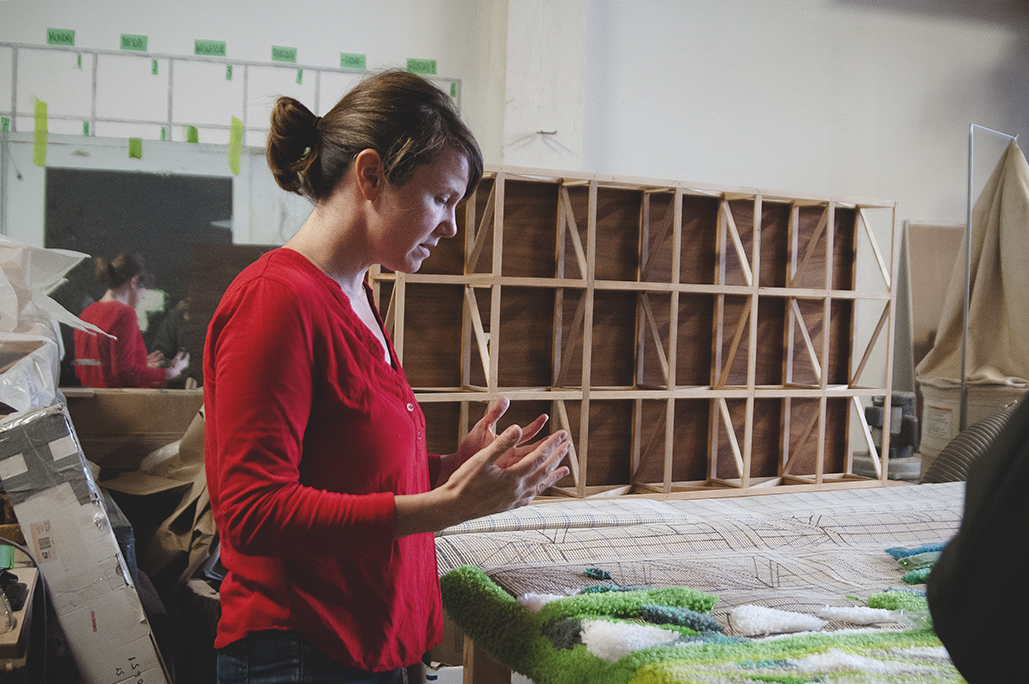
Kelly has previously produced large-scale installations, focusing on the stage as a site of inclusive narrative-building through works produced for the University of Buffalo Art Gallery and the Hyde Park Art Center. Kelly’s adopted roll of director turned her focus inward to the studio, observing the choreography associated with the performance of making. Recently Kelly has begun to deconstruct the stage by letting its objectness inform her work—obscuring its shape through video, and building upon its form through print.
I\W: How did the stage form enter your sculptural practice?
KK: I had built a reputation over the last twenty years with large-scale installation work. In some ways it is harder for me to produce smaller works than the large productions, but I have been trying to figure that out. The stage seems to proliferate in my work despite the fact that I have never thought of myself as making work that was repetitive in form. It began after a piece called air is air thing is thing – a recreation of Marcel Duchamp’s Etant Donnes with separate, independent structures that coalesced to form the figure in the negative space. After that I was asked to propose a work for the University of Buffalo art gallery and I knew that I wanted to make an epic. I didn’t really know what that meant, but I decided that to make an epic, I needed to somehow write a play.
What was your approach to creating a play without a background in theater?
I knew that if I was to write a play, I would need to set a scene. The first act was, Scene From ‘Olympus Manger.’ The idea was to use the stage so the scene played itself out, or was writing itself as it was existing, like a self-generative script. I built the stage as the basis for the actions that would occur, and then it was the participation of the audience that produced the narrative. There were two holes. People poked their heads into the hole and saw a landscape underneath the stage. What interested me was a kind of pulling apart of the actor/audience. What the actors were seeing opposed to what the audience was seeing, which was a body lying prone. I liked that the scene was intimate, vulnerable, and awkward.
When I was asked by Hyde Park Art Center to do a project, I wanted the second scene, ‘Olympus Manger,’ Scene II, to have an opposite gesture or narrative. I wanted a play about communal labor, or where the focal point was less about vision and more about bodily labor. If you were on the stage doing the tug-o-war, you would be paying much less attention to what everything looked like, and much more attention to the efforts of completing the action. Meanwhile the audience had a vision of what’s occurring as a whole, which was this communal labor.
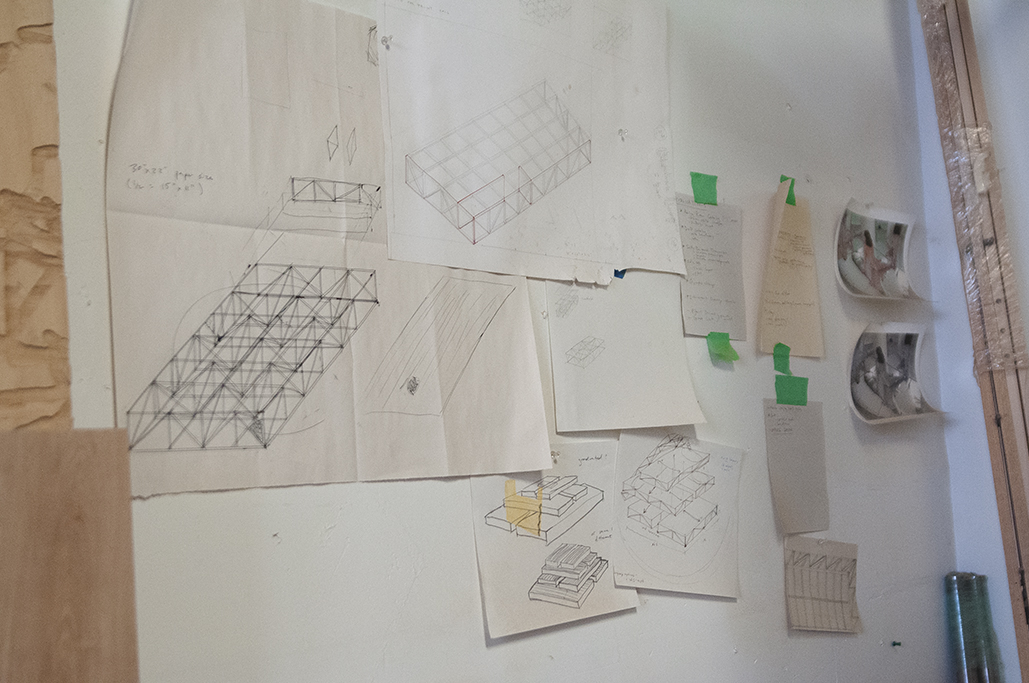
What elements of your practice did this interrogate?
From there a number of questions started coming to the surface in my practice. One was this question of performativity. Unlike the kind of ideals of social practice, I wasn’t particularly interested in how people felt as their participation fulfilled the work. I needed them to fulfill the narrative. It wasn’t discursive. It was about communal labor, but not community. It was creating an image, like a pictorial space, that points to systems of governance and tectonic shifts. So, this work made me question my role as director in relation to performance. From there, I embarked on a series of works that began to examine performativity in the object – the stage – as well as the studio itself.
Would you consider the works plays without narrative?
No, they were producing narrative, but the narrative was one of dialectics. It was intimacy and monumentality. It was privacy and public. It was the lone body and the public body. Olympus Manager is a title that speaks of opposites. It ended up being a play that produced narrative about a historical, dialectical language instead of a plot or storyline. It also produced this question of performativity relative to me. With the Hyde Park Art Center installation, I especially felt like I was acting as an omnipotent director. This was in contrast to the studio where I had the role of a performer – performing the choreography of making. The ThreeWalls’ show The Stagehand’s Unseen was meant to work through the dialectics of the play. And there is where I realized I was really interested in the stage itself. The stage as this thing that wasn’t an object, but was a sign for a platform for an infinite number of narratives or content to exist on. I started playing with how the stage described this language of being this in-between of objectness. How can it be a thing which is an object, a monument, and a platform at once?
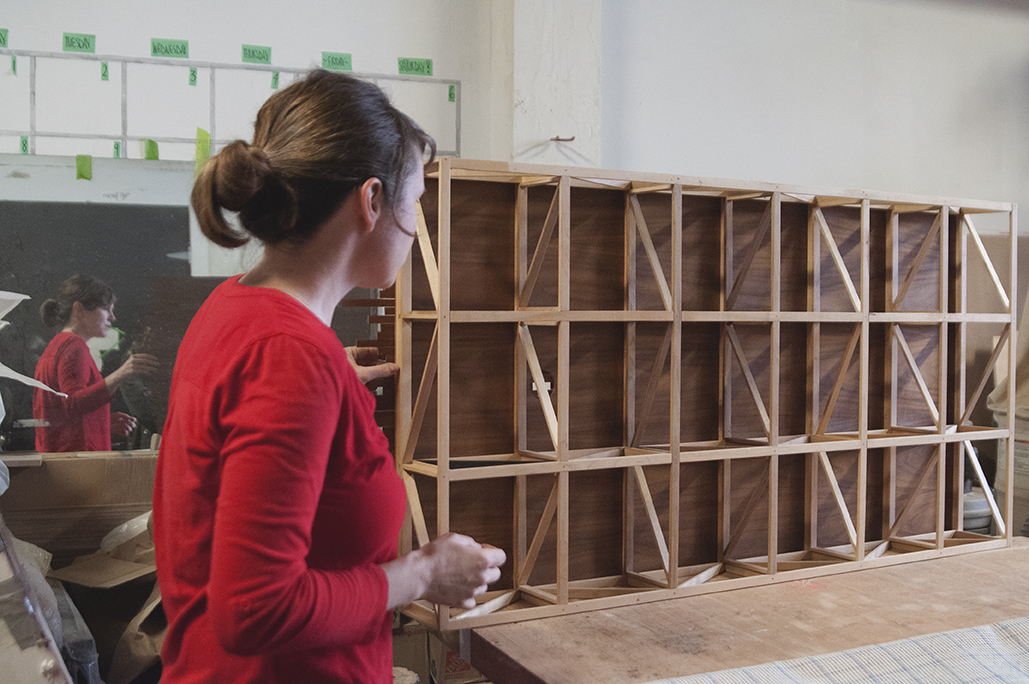
Do you feel as if it was a plane where anything could be projected?
Right. I started producing models of stages which allowed me to reprocess. All of the lumber that was in the large scale installations would come back to the studio and be dismantled. The stages were always built as temporary structures, not the stages with a proscenium housed in a building. It was a traveling or nomadic structure. It meant that I could unbuild it and bring it back to the studio. The iterations were constantly scaled down as I would reuse the materials by ripping the lumber. These iterations were never models of an original, rather they were proportionate to their own concerns in relation to the body. They were scaled like models, but I was thinking of how the scaled object is related to the body. And how the body has a desire to fulfill this infinite potential narrative on the stage.
The stage allows me to think structurally and linguistically. The stage also brought me to a piece called Study for Convergence Performance, a set of videos that I did with a green screen which helped me talk about this idea of the performativity in the studio.
Did you consider the green screen a stage as well?
It was a stage literally. In the first video, it was a stage that keyed the image of the Bonneville Salt Flats in Utah upon which I built an object, like a drawing in space. It ended up being this boulder-like form. As I built, it began to fragment my body while building it. You could only recognize its form when it was in motion. I used the Salt Flats as a landscape referencing Smithson and his ideas of site and nonsite. What is landscape when we no longer need to visit it? I was thinking through the site of production as the artist’s studio, the site of presentation being the video itself as well as display and landscape as a physical site we can arrive to virtually. In the video there is a point of animation. A friend of mine, video artist Todd Mattei, animated a sequence in which he took all of the marks made from the cut and sanded edges of the object that were abstracting the field and had them perform actions that couldn’t have existed in a physical site. I wanted to try and collapse these sites and think about how to perform the making of something where nothing really exists as a whole across the sites.
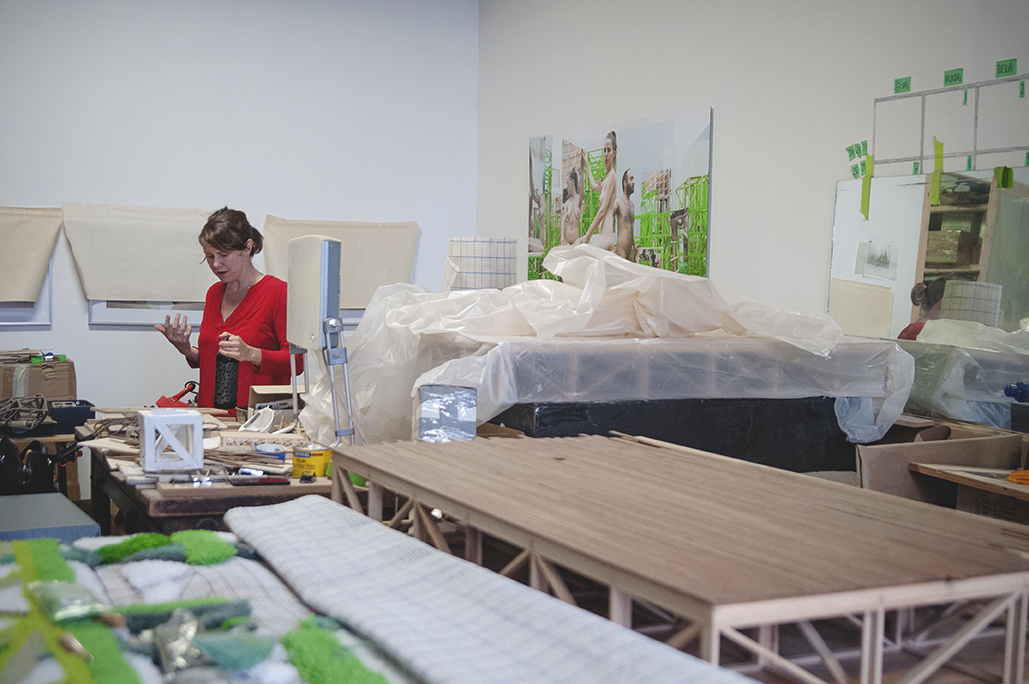
How did this work with green screen transition to your recent photographic work?
This series of photographs, Study with Chroma, are made with two photographs where the first one is just the green screen and objects in the studio, and then the second photograph I reenacted the same composition mapped from the original photographs and placed nudes with mirrors. The two photographs are stitched together by removing the chroma fore and aft. I was interested in equalizing the figure-ground relationship so the ground, in this case the landing for chroma, is brought to the status of subject. I also think I had to work with friends in the nude before I could do it myself. The photographs, titled Oh! Oh! Oh! were shown at Peregrine Projects. They are a suite of images based on the eight positions in Charles Ray’s Oh! Charley Charley Charley. I was interested in the arrogance and lack in the work. My work has pushed up to a patriarchal histories in sculpture practices. These men and their practices are of my history, the forefathers that I follow and am interested in, but frustrated by.
This piece was interesting to me in a type of truncated or refused longing. The orgy was an image of an orgy but there is no touching, no penetration. Also I have not actually seen the sculpture in person, only in documentation. So the internet comes into the work in this way that it kind of marries or parallels ideas about how it is that we move into each other or understand or get to know what proximity, maybe touch, might be. I downloaded images of the piece off the internet, images that other people took, people that went to the show and saw the work. I tried to get as many views of it as possible so I could understand how to reposition myself in space as any one of the isolated images.
Do you have any further plans with this series?
I am excited to pursue the second part of the series as a three dimensional form. I want to take the space between the figures to create a terrain or platform or stage where the body can be filled in, but it is always the virtual body. I think the last couple of years have gotten waylaid in working out the virtual part of the project. I am trying to figure out smaller things to work with, simpler steps to keep going. The stage for Oh! Oh! Oh! will ultimately be made out of wood on a 1:1 scale. The bodies won’t be there, but the negative space will be defined and will in part talk about resolution and ambiguous information in seeing virtually. It will be as if the surface of the stage is lifted up like your body is in quicksand, and then the quicksand hardens and the body is removed except that because this is happening with the photographic image of the figure, the virtual rendering has to fill in the blind spots.
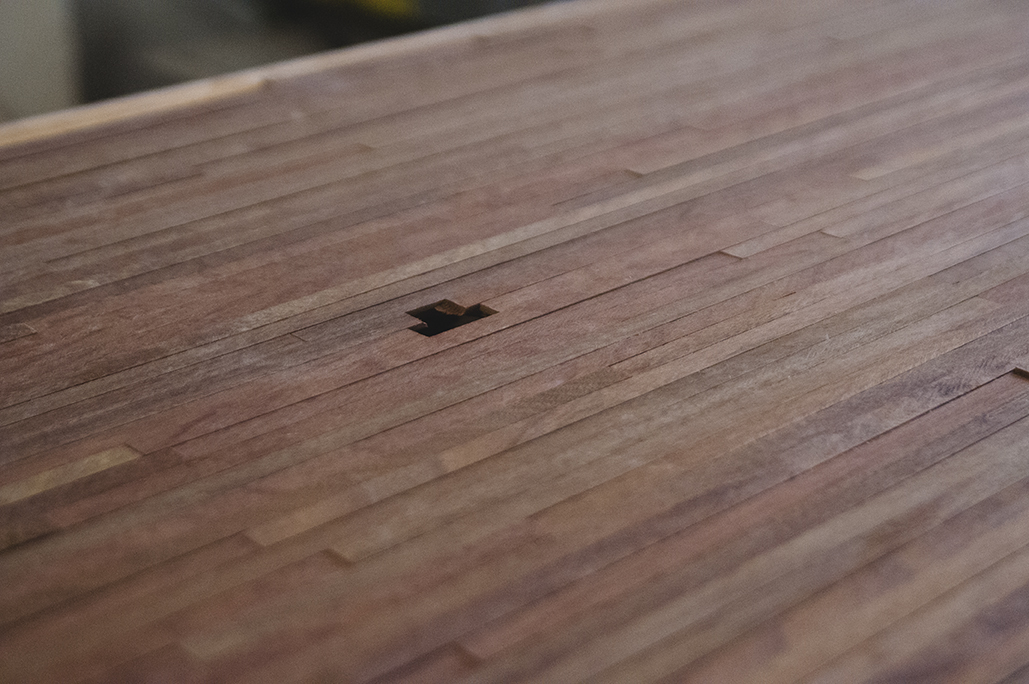
How has the stage transitioned to your recent printing project with Stan Shellabarger?
Stan contacted me about a year and a half ago and asked if I wanted to do a print project with him at Spudnik Press. The deal was he would be operating like a master printer. I would come up with a project and make decisions. He would provide the paper and the ink. In exchange, Stan and Spudnik Press get a set of prints. I came up with this project that is a relief print, a kind of puzzle I built to place the form in different configurations. Part of this project’s thinking was the the idea of producing iterations from a single form and where could it lead me. How could I break it apart but still have it come together? I thought I would act on the print like I would be building in space. How would I build a stage on paper and how would that somehow be the same or different as doing it in actual space? Also, I’m hoping to leave the stage form somehow by pushing through iterations, if that makes sense. Do it more to leave it. It might be a while though.

At this point there are about 60 finished in this box, but we are working on about 75 or so total. It’s developed into a large portfolio of one of a kind prints, built one scaffold at a time through the press. It has been well over a year and, through this time, I can honestly say sometimes I get extremely excited about them, and sometimes I just don’t know. I have learned a lot. While the prints have been building, they have allowed me to respond to optics and color in ways I’ve never thought through. The prints are extremely layered and textured when you see them in person. But mostly what the project has done for me this past year and a half is that 5 hours every week I show up for Stan because he shows up for me, for the work. A lot of it for me has been about building a relationship with this other person that is there for me in a time in my life where that dedication means the world. For five hours every week I am there with Stan to make the work and I am forever grateful for this time, for Stan’s remarkable patience. And I’m nervous to move on, but its almost time and, as Stan and I have discussed, I have things to do, work that is waiting for me to dedicate that same time to.
